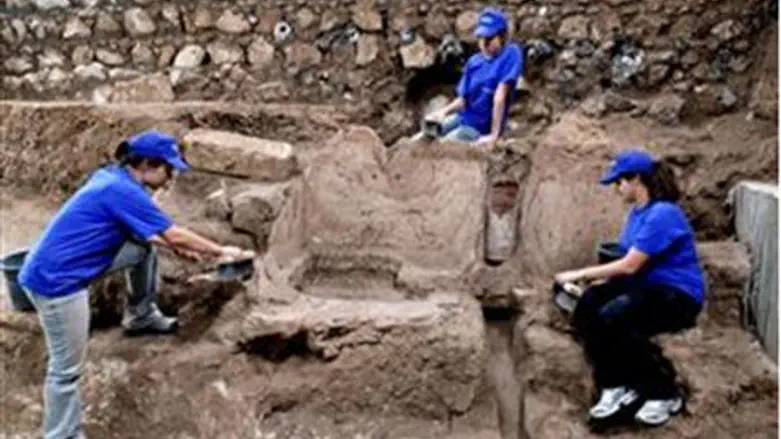
It's a case of history repeating itself – at least partially. Archaeologists who have been helping to prepare an area in the Jewish Quarter of Jerusalem's Old City for construction of a mikveh (ritual bath) were stunned to discover that the exact same spot had been used for bathing purposes thousands of years ago. They uncovered an empty stone pool there, apparently part of an ancient Roman-era bathhouse that stood on the spot.
The archaeologists dated the pool to between the years 200 and 300 C.E., meaning that the structure is at least some 1,800 years old.
Dr. Ofer Sion, head of the Antiquities Authority archaeological team that uncovered the pool, said that team members were as surprised as anyone else by the finding – not only because of the context in which the discovery took place, preparations of the site for another bathing facility, but because of the pool's good condition.
“Inscribed on the pool's tiles is the legend 'Leg X Fr,' a reference to the Roman Army's tenth legion that has been seen on other sites. The inscription indicates that the soldiers were the builders of the pool,” says Dr. Sion. Atop the floor tiles were hundreds of roof tiles, indicating that the pool was covered.
The pool and its attending bathhouse, says Dr. Sion, were apparently part of the Roman Empire's “Aelia Capitolina” project, which was implemented to erase the name of Jewish Jerusalem after the failure of the Bar Kochba rebellion in 135 CE. “The tenth legion was brought into Jerusalem after the rebellion was put down, when the pagan Aelia Capitolina city was built. The legion was thought to have operated in the area of the modern Armenian Quarter of the Old City, and the discovery of their pool in the nearby Jewish Quarter confirms this,” Dr. Sion said.
Besides the legion's calling card, archaeologists found another interesting item at the site, Dr. Sion said – the imprint of a dog's paw. “It's possible that the dog belonged to one of the soldiers, and its paw got imprinted on one of the roof tiles, either accidentally or as a humorous gesture,” he said.
Antiquities Authority official Yuval Baruch said that the discovery was an important one, because it was the first evidence of the Roman Legion in the Old City. “Until now, it was thought that Aelia Capitolina was very small," he said, "but this discovery shows that the project was much larger than had been previously believed. Research on Aelia Capitolina is very important, because the changes made then were instrumental in setting what we currently see in the Old City."